 |
|

|
 |
TABLE of CONTENTS
 |
FHWA’s Tom Sorel appointed as Mn/DOT’s commissioner |
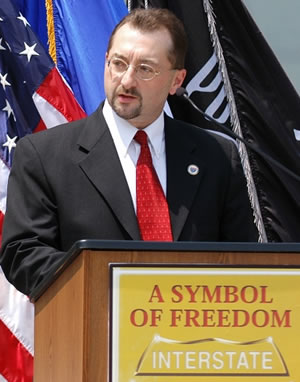
Tom Sorel, who begins his appointment as state transportation commissioner on April 28, is seen here in June 2006 when he spoke before Mn/DOT employees as part of Minnesota's year-long celebration of the 50th anniversary of the interstate system. Photo by David Gonzalez |
Tom Sorel, director of the Federal Highway Administration’s Minnesota Division, was appointed as Mn/DOT commissioner by Gov. Tim Pawlenty on April 21.
His new position begins April 28.
Sorel succeeds Bob McFarlin, acting commissioner, and Lt. Gov. Carol Molnau, who served in the post during the past five years.
Sorel has held various positions with the FHWA since 1978.
His previous experience includes serving as a major project team leader in Washington, D.C., and as director of planning and program development and chief of technology services in Albany, N.Y.
During the 2002 Winter Olympic Games in Salt Lake City, Sorel was the USDOT liaison for federal transportation issues and led efforts to build the infrastructure for the event.
“With 30 years of transportation experience and a civil engineering background, Tom Sorel is the right person to lead Mn/DOT,” Pawlenty said.
“Minnesota has invested more in roads over the last five years than ever before,” he said. “Tom Sorel will provide the leadership as we continue to build a modern and efficient transportation system for Minnesota.”
Sorel earned a bachelor’s degree in civil engineering from the State University of New York at Buffalo and a master’s degree in business administration from Thomas College in Waterville, Maine.
He also earned a certificate in conflict management from the Cornell University School of Industrial and Labor Relations in Ithaca, N.Y., and an associate certificate in project management from George Washington University in Washington, D.C.
In addition to many FHWA performance awards, Sorel received the Presidential Honor for leading the federal transportation response, recovery and rebuilding efforts in Minnesota in the aftermath of the Interstate 35W bridge collapse in Minneapolis.
He serves on the boards of the Center for Transportation Studies at the University of Minnesota, Minnesota Guidestar and the Transportation Engineering and Road Research Alliance.
|
 |
|

|
 |
TABLE of CONTENTS
 |
Winter’s end? Icy blasts, heavy snow mark season’s finale in northern Minnesota |
By Craig Wilkins
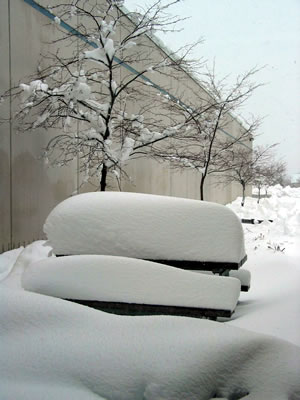
It was April 11 when this photo was taken, but Mn/DOT employees would have to wait for a good warm-up before anyone would be eating lunch at these snow-covered picnic tables outside the Baxter district offices. Photo by Dan Johnson |
One observer, District 1’s John Bray, described the April 11 storm that slammed Duluth and the region as a “frozen hurricane.”
The fierce storm turned the placid ship canal in the Duluth harbor into a roiling cauldron of snow and water churned by winds of 50 miles per hour. Frothy, wind-whipped waves nearly splashed onto the deck of the city’s landmark Aerial Lift Bridge.
Accumulated snow and ice plagued the region until maintenance crews, helped by warm pavements, regained control of the highways.
Gary Dirlam, District 3 maintenance engineer at Baxter, said the heavy, wet snow created tough sledding for maintenance crews.
“At times, there were white-outs, and the heavy snow and slush were a strain on the equipment. Even our heavy equipment had a hard time getting around in the snow-covered slush, hindering efforts to open up the district headquarters to the public,” he said.
“We had a lot of compacted slush and snow, but warm pavements, long crew hours and using chemicals helped get roads clear,” Dirlam said.
The April 11 storm brought heavy snow and strong winds to Bemidji , Brainerd and many other locations including the outer reaches of the Twin Cities metro area.
Mn/DOT maintenance crews met the storm head-on, but not before urging motorists to avoid any unnecessary travel.
Storm conditions forced school closings, shut down government offices and some shopping malls. Duluth suspended transit service for most of the day.
Bray, public affairs coordinator with Duluth/District 1, joined the chorus of public officials urging people not to travel until the storm had passed.
Bray told the Duluth News-Tribune, “My advice is that people should just put wood on the fire, pet the dog and look out the window, but stay home.”
Dirlam said district crews are now out patching under sunny skies and looking forward to getting caught up on road repairs.
“I hope this was the last storm,” he said. “We have a lot of spring highway work to do out there.”
|
 |
|

|
 |
TABLE of CONTENTS
 |
Red light, blue light: Added signal gives police new angle to ticket red-light violators |
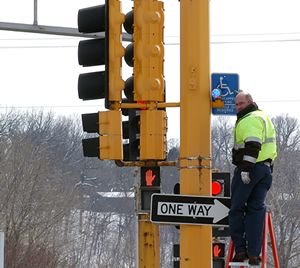
A Burnsville city employee tests the blue signal light that alerts police when traffic lights turn red to support enforcement efforts. Photo by David Gonzalez |
By Craig Wilkins
A blue light mounted on traffic signals gives Burnsville police a safer, more effective way to ticket motorists who run red lights at highway intersections.
Jerry Kotzenmacher, a senior engineering specialist with Traffic, Safety and Operations, worked with city engineering and law enforcement officials to develop the system.
The signals are installed on Highway 13 at its intersections with County Road 5 and County Road 11.
Minnesota law requires that a police officer witness an illegal act, such as a driver going through an intersection after traffic lights turn red, in order to issue a citation.
To meet that stipulation, Burnsville officers had to wait facing the light in full view.
Now, however, officers can park on a side street and tell if a driver is in violation by observing a blue light that comes on simultaneously when the traffic lights turn red.
Instead of going through the intersection to chase violators, an officer can now see the violation and pursue the vehicle by making a safe and easy right-hand turn onto the highway.
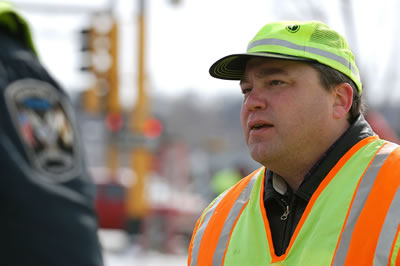
Jerry Kotzenmacher, a senior engineering specialist with the Office of Safety, Traffic and Operations, confers with a Burnsville police officer during installation of the red light monitoring system on Hwy 13 in Burnsville. Photo by David Gonzalez |
The city of Bloomington plans a similar installation, Kotzenmacher said.
The system is low-cost, he said, about $250 per approach. It takes about one hour to install the light on an existing signal.
Burnsville traffic and law enforcement officials will monitor how well the system works; Mn/DOT will test how well the signal light system holds up to weather, traffic and other conditions.
Burnsville officials and Kotzenmacher expect the system will increase arrests, but they said their overall goal is to make drivers aware of the dangers at intersections and to make better driving decisions.
“This system fits well into our Toward Zero Deaths campaign,” Kotzenmacher said. “It’s another tool to help reach that goal.”
|
 |
|

|
 |
TABLE of CONTENTS
 |
Mn/DOT observes Workers Memorial Day April 28 |

On April 28, Mn/DOT employees will honor co-workers who have been injured or killed on the job. Graphic by Paula Gustafson |
Since 1960, 31 employees from Mn/DOT have lost their lives in Minnesota work zones.
On April 28, 2008, Mn/DOT will pause to remember these transportation workers as well as those who have been injured while on the job. A recorded message by Mn/DOT’s Operations Division Director Bob Winter will be played on public address systems in most Mn/DOT buildings. After that time, employees in other locations can hear the message via computer by linking to the iHUB calendar at http://ihub.dot.state.mn.us.
In addition, some districts will be holding their own Workers Memorial Day events.
For more information about Workers Memorial Day nationwide, go to http://www.aflcio.org/issues/safety/memorial/. |
 |
|

|
 |
TABLE of CONTENTS
 |
Spring Maintenance Expo helps participants gear up for warm weather highway work |
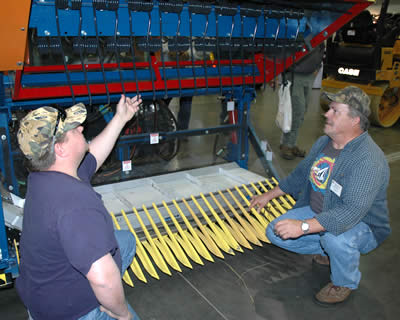
District 3 employees Terry Gregoire, Baxter, and Dave Benjamin, Garrison, check out the trash harvester prototype at the Spring Maintenance Expo in St. Cloud. Photo by Craig Wilkins |
By Craig Wilkins
Leaden skies, traces of snow and strong wind gusts prevailed outside the St. Cloud Convention Center on April 17.
But inside, the mood brightened as participants swarmed over an automated trash collector, mowers designed for use near guardrails and other new equipment at the annual Spring Maintenance Expo.
The event was held April 17-18 in St. Cloud and attracted participants from several levels of government looking for new and better ways to maintain highways and roadsides.
The new trash harvester, for example, attracted visitors like a new patch of clover draws bees.
The self-propelled vehicle was quickly renamed the “litter picker” by enthusiastic visitors. A small group of people started making suggestions to modify the prototype on display before it could clear its first mile of roadside vegetation.
DeWayne Jones, a Metro District superintendent, said the trash harvester will first see duty along freeways in Minneapolis.
Jones credited Bob Wryk, now District 1’s maintenance superintendent, for originating the idea.
The device uses long, metal tines similar to a hay baler to pull paper and other trash out of grassy areas without affecting the vegetation.
Jones and others examining the harvester said it would speed litter pick-up and improve safety for maintenance crews.
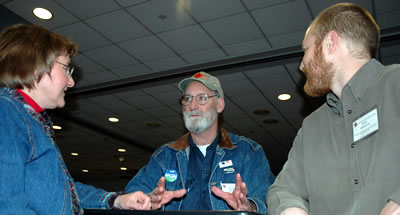
Continuing the discussion after a session on roadside prairie restoration are (from left) Carmelita Nelson, Department of Natural Resources; Hugh Smith, a transportation generalist at District 8’s Granite Falls truck station, and Ken Graeve, Environmental Services. Graeve, a natural resources program coordinator, led the session. Photo by Craig Wilkins |
They noted the efficiency of a having a single operator collect litter and store it in one pass.
Participants also commented how it can reduce the number of workers exposed to traffic as well as prevent potential injuries from gopher holes, steep ditch slopes and other roadside hazards.
In a nearby seminar, presenter Brian Alexander combined his safety expertise, magic tricks and bits of humor to encourage highway workers to stay safe by keeping their focus on the task at hand.
Alexander showed blurred images, performed card tricks and demonstrated other sleight-of-hand movements to show how easily the eye can be fooled.
“Illusions happen,” he said.
Alexander served as a safety officer with Mn/DOT in the mid-1990s.
He said organizations need to create a culture where no one feels uneasy about following safety practices.
“If everybody does it, there’s no need to feel awkward about wearing hard hats, using seat belts, wearing protective eyeglasses or anything else,” he said.
Alexander also appealed to each participant’s self-interest.
“Putting safety first can, for example, let you keep hearing your favorite music, walk up a flight of stairs without pain or play on the floor with your grandkids,” he said.
Other workshops addressed workplace communications, work zone traffic control, brush and weed control plus several other topics.
|
 |
|

|
 |
TABLE of CONTENTS
 |
Schadauer will lead Mn/DOT’s Office of Transit |
By Craig Wilkins

Mike Schadauer, currently director of Mn/DOT’s Metro District Transit Section, will become the director of the agency’s Office of Transit, beginning June 2.
|
Mike Schadauer was named director of the agency’s Office of Transit, beginning June 2.
Schadauer currently serves as director of Mn/DOT’s Metro District Transit Section.
He succeeds Donna Allan who retired in February.
Judy Ellison, Transit, will serve as acting director until Schadauer’s appointment becomes effective.
In his new position, Schadauer will manage Transit’s grant programs for Greater Minnesota transit systems, participation in the Rural Transportation Assistance Program, development of the Greater Minnesota Transit Plan and Mn/DOT’s bicycle and pedestrian initiatives.
Tim Henkel, Planning, Modal and Data Management Division director, cited Schadauer’s experience with major transit projects and his leadership and management skills among his qualifications for the post.
Schadauer joined Mn/DOT in 1983 after earning a bachelor’s degree in civil engineering with an emphasis in transit from the University of Minnesota.
Schadauer first worked in surveying, mapping and land acquisition and management. His duties included applying automation to survey field crew operations and incorporating state mapping data into the national geographic information system.
In 1998, Schadauer was appointed as Mn/DOT rail project development engineer. In that role, he managed preliminary design of stations and environmental reviews for the Hiawatha light rail transit project in Minneapolis.
Schadauer was promoted to his current position with the Metro District in 2001.
His current duties include managing several aspects of the Northstar commuter rail project, Mn/DOT’s role in Twin Cities metropolitan transit way planning and various aspects of the proposed Central Corridor light rail project in the Twin Cities metro area.
|
 |
|

|
 |
TABLE of CONTENTS
 |
New TSS Web page lists job specifications, standardized qualifications |
|
By Craig Wilkins
Mn/DOT employees may now view updated specifications for the Transportation Specialist Series class on the department’s iHUB Web site.
Subject matter experts, including TSS employees, supervisors and managers departmentwide, worked with a cross section of human resources staff to develop job class specifications and minimum qualifications for each class, said Theresa Johnson, Human Resources staffing manager and TSS Project team member.
The team developed class specifications by function: snow and ice control, surveys, rights of way, traffic engineering, etc.
There is also a glossary which defines terms relevant to TSS positions.
Positions in the series include transportation generalist, senior transportation generalist and transportation specialist.
Creation of the revised class specifications resulted from supplemental bargaining agreements reached by Mn/DOT and AFSCME as well as in TSS Labor-Management Committee discussions.
The team’s work, Johnson said, helps ensure that vacancy posting will be consistent and job-relevant throughout the department, and that employees can determine which skill sets are needed to move from one function to another.
Information about the TSS class by is available at http://ihub.employee/career_center/TSS_Class_Specifications.html.
Employees may comment about the specifications and qualifications to any TSS Labor-Management Committee member for consideration, Johnson said. To find TSS committee members, contact your local human resources office or union representative.
The committee plans to review comments and suggested improvements in January 2009.
|
 |
|

|
 |
TABLE of CONTENTS
 |
Pride and prejudice |
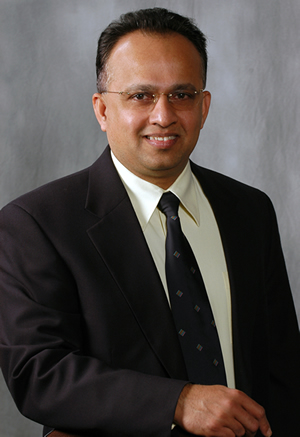
Nandana Perera is a staff attorney in the Office of Human Resources and Administration and a member of Mn/DOT's Diversity Committee. Photo by David Gonzalez |
By Nandana Perera
As a teenager, I pitied a blind man who was selling peanuts on the street in a remote village in Sri Lanka. After buying 25 cents worth of peanuts, I told him to keep the change. Guessing I sympathized with his disability, he gracefully refused. When I insisted, he said, “You are most kind and generous, sir. Thank you, but I would rather get paid for what I sell.”
One may say that the man’s response was nothing more than pride. But I learned a unique lesson.
We have many programs to help or accommodate people like that blind man, including affirmative action, equal employment opportunity and diversity programs. These are intended to help protected groups–people with disabilities, ethnic minorities, women and people of different religious faiths and national origins.
Why help them? Some say it is to remedy the effects of past discrimination. Some say having a diverse work force is a business necessity. Certainly, there is little disagreement that there has been past discrimination against African-Americans or people with disabilities or different sexual orientations or national origins.
But how do we redress or remedy past discrimination?
Even the justices of the U.S. Supreme Court disagree on this. I sometimes wonder how I come in to the picture at all—there was no past discrimination against people of Sri Lankan origin in the U.S. If the purpose of affirmative action and diversity programs is to remedy past discrimination, why did the Congress include persons of all national origins in civil rights legislation?
Why is it a business necessity? Just walk into a big shopping mall and you’ll see.
In my law enforcement work in Sri Lanka, I found that most of the gold and heroin smugglers belonged to two minority ethnic groups in Sri Lanka. I still struggle when that prejudice hits me, when I read news stories or hear about people from those ethnic groups. Call me racist if you like, but first ask yourself: How guilty am I–compared to you? The truth is, stereotypes—positive and negative—are born from our own social experiences and resulting perceptions.
How do we change those perceptions?
Before others accept that I am their equal, I must first accept it myself. I must agree to play by the same rules, not expect favorable treatment because I am different, tell others not to expect less from me because I look and sound different, and ask them to challenge me. This attitude has done wonders for me.
Speaking for myself, I want to be paid for what I can deliver. Not for what I can deliver plus the color of my skin or my national origin.
Yes, just like the blind man.
Nandana Perera is a staff attorney in the Office of Human Resources and Administration, where he administers the Transportation Regulation Proceedings Program in the Risk Management Section. Perera has worked at Mn/DOT since 2005, first as a Seeds student before being hired by his current office. He is also a member of the department’s Diversity Committee.
|
 |
|
| |
|



